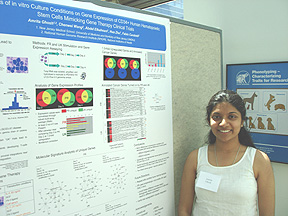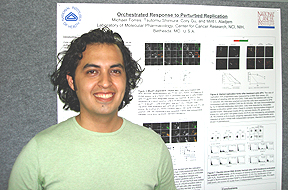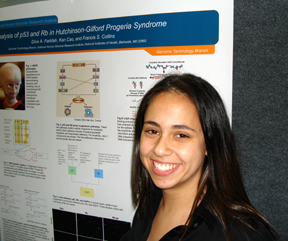May 4th GPP Student Research Symposium
GRADUATE
STUDENTS AT NIH
DISPLAY
THE RESEARCH DOCTORATES
ARE MADE OF
by Evan Galloway


Teresa Ferguson
(Mentors: Wayne Drevets, NIMH, and Arne Öhman, Karolinska Institutet, Stockholm )
"Mood Congruent Processing Biases in Amygdala Response to Backwardly Masked Emotional Facial Stimuli in Major Depressive Disorder"
Authors: Teresa Ferguson, Maura Furey, Stephen Fromm, Harvey Iwamoto, Arne Öhman, and Wayne Drevets
Amrita Ghosh
(Mentors: Fabio Candotti, NHGRI, and Hua Zhu, University of Medicine and Dentistry of New Jersey, Newark)
"Effects of In Vitro Culture Conditions on Gene Expression of CD34+ Human Hematopoietic Progenitor Cells Mimicking Gene Therapy Clinical Trials"
Authors: Amrita Ghosh, Chenwei Wang, Abdel Elkahloun, Hua Zhu, and Fabio Candotti
Dysfunctional activation of the amygdala, a major mediator of emotion, has been associated with various mood disorders, including depression. Specifically, the amygdala of a depressed individual tends to exhibit abnormal patterns of activation in response to negative or positive stimuli.
In this study, Teresa Ferguson and her colleagues used blood oxygen level–dependent (BOLD) functional magnetic resonance imaging (fMRI) to further investigate this effect among patients with depression, patients in remission from depression, and healthy control subjects. Images of happy, sad, or neutral faces were presented to the cohorts for a brief-enough period of time to fall below the level of conscious detection, permitting the measurement of automatic or implicit responses.
Ferguson found that the amygdala of a depressed patient, compared with that of a healthy control subject, exhibited increased activation in response to sad faces. When presented with happy faces, on the other hand, the control subjects showed greater activation than both remitted and currently depressed patients.
These results support the idea that abnormal amygdala responses are a key attribute of depression, and they demonstrate the existence and influence of automatic or implicit responses.
Ferguson
suggested that these findings might help explain why depressed individuals
tend to ruminate on the negative aspects of their environment and their
lives. She is currently investigating the effects of antidepressants in
this response. ![]()
Amrita Ghosh presented both a talk and a poster on her research to replicate the in vitro conditions in two similar clinical gene-therapy trials. One, in France, had resulted in four cases of leukemia, and the other, in the United Kingdom, had not. Her interest, she said, is to optimize trial safety.
Ghosh used a stem-cell culture model to examine the differences in culture conditions in the French and British gene-therapy clinical trials. Both were equally successful at inducing the intended therapeutic response—amelioration of X-linked severe combined immunodeficiency—and both had used retroviral vectors, which are believed to preferentially integrate into actively transcribed genes.
Ghosh and her colleagues hypothesized that different outcomes may be explained by differential integration of the vector, which in turn is determined by differences in gene-expression profiles. Replicating the dissimilar conditions of these trials in vitro and assaying for RNA expression allowed Amrita to probe these differences.
She found that annotated cancer genes were indeed overrepresented among the activated genes in all the French culture samples, whereas this effect was observed in only one U.K. sample. If confirmed, these results may indicate preferential integration into cells cultured by French conditions, perhaps resulting in dysregulation of more cancer genes than in the U.K. cultured cells. Further work will be directed toward examining differences caused by the type of retrovirus used and ensuring that "upregulation equals integration."
Ultimately, Ghosh says, "the goal of this work is to help make gene
therapy a part of conventional medicine." ![]()
GPP
Standouts:
Eight Student Posters, Two Mentors
The following GPP students received poster commendations and a $500 travel award:
Molly Bright, University of Oxford, U.K. "Characterization of Regional Variability and Correlated Processes in BOLD fMRI During Mild Hypercapnia" (Jeff Duyn, NINDS)
Kee Chan, Yale University, New Haven, Conn."T-Cell Receptor Excision Circles: Application to Newborn Screening for Severe Combined Immunodeficiency and Understanding the Development of T-Cell Diversity" (Jennifer Puck, NHGRI)
Gabriel Eichler, Boston University. "Embracing the Complexity of Gene Expression in the Interpretation of Gene Microarrays" (John Weinstein, NCI)
Athena Klutz, The Johns Hopkins University, Baltimore, Md. "PAMAM Dendrimers Serve as Nanoscaffolds for G-Protein—Coupled Receptor Ligands" (Kenneth Jacobson, NIDDK)
Paul Kriebel, George Washington University, Washington, D.C. "Vesicle Trafficking is Essential for the Proper Cellular Distribution of the Adenylyl Cyclase ACA and cAMP Release During Chemo-taxis and Streaming" (Carole Parent, NCI)
Justin Lathia, University of Cambridge, U.K. "Neural Stem Cell Behavior Regulated by Integrin/Laminin Interaction in the Developing Embryo" (Mark Mattson, NIA)
Thomas Lozito, University of Cambridge. "Endothelial Cell Matrix Influences Mesenchymal Stem Cell Differentiation into Vascular Cell Types" (Rocky Tuan, NIAMS)
Jennifer Schymick, University of Cambridge. "A Genome-wide Association Study of Sporadic Amyotrophic Lateral Sclerosis" (John Hardy and Bryan Traynor, NIA)
And
Francis
Collins, NHGRI,
and Kurt
Fischbeck, NINDS, were honored as
this year’s "outstanding mentors," chosen from among the
nominations submitted by the graduate students. ![]()

